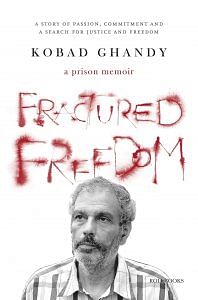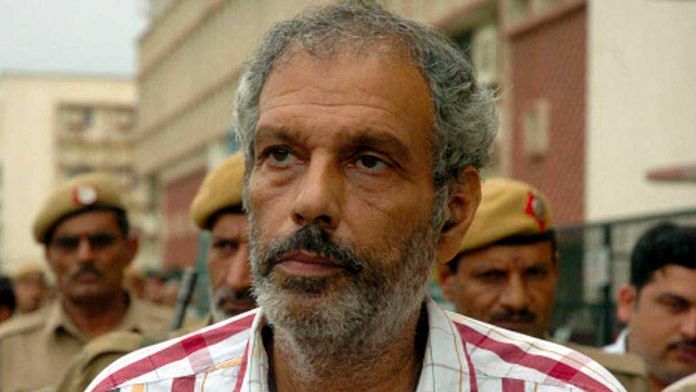Due to major prison struggles in the 1990s, in Andhra Pradesh at the time Naxalite prisoners were given the status of political prisoners. excellent wards were constructed specifically for Naxalite prisoners in this jail. each cell had a TV, running water and a wash basin, 2-3 cells would also have a Western-style toilet, and each had a block on which to sleep. The food was good and the tea was like at home. Mulaqaat, with both visitors and lawyers, was allowed inside the DS’s room sitting on chairs.
After Tihar, it would appear that I had ascended from hell to heaven! The ward had been planted with all sorts of fruit trees – coconut, guava, mango, papaya – drumsticks, lots of curry patta plants and heaps of roses and mogra, all by Ganesh. There was a badminton court on one side but due to my arthritis I could not play. The food, as I mentioned, was excellent compared to Tihar and the inmates and staff decent people. I would do yoga on a platform under a neem tree and in the evenings another young NDPs undertrial and I would take long walks outside the ward, with me teaching him spoken English (he was fluent at reading English).
After about six months at Hyderabad jail I was taken to Patiala by train to appear there for a different case. I had expected to be presented and immediately return, but the judge insisted I remain there until the case was being heard; so I was sent to Patiala prison for the twenty days that the case lasted. As it happened it turned out for the best.
The Patiala jail covered a huge area as it was from the Maharaja’s times. The bulk of the inmates in the jail were there on drug-related cases which is a serious problem in Punjab. I was put in the hospital which housed a number of ‘VIPs’ and other well-connected inmates. The biggest was a co-accused of one Bhola, ex-IGP and reportedly a major player in the drug mafia of Punjab. Bhola’s associate (cannot remember his name) took me under his wing and every evening when I returned from court gave me an excellent home-cooked meal. As I’ve mentioned, in most jails people with money have access to all benefits.
Also read: Kobad Ghandy — Doon School alum ‘Maoist’ who has been in jail for 10 yrs despite acquittals
In all the jails I noticed the big-time underworld generally had a liking for Naxalites as they too had a Robin-Hood type image. Also on the very first day some Sikh leaders (I think they were Nirankaris) learning of my arrival came up to me and said they had a system of phoning and I could use it anytime I wanted. When I did, I found it a sort of social service for poor inmates to which the authorities also seemed to turn a blind eye. In addition, a friend of my erstwhile co-accused (whose charges had been dropped) – a Dalit Sikh – met all my expenses in jail and was very keen to know more on the philosophy of the movement. The entire day I would spend at the court each day and return only in the evenings. Overall, the stay in Patiala was relaxed and the court procedures fast and efficient. One observation was that the entire Sikh community with whom I came into contact – inmates, lawyers, judge and even the entire police escort – seemed to have immense respect for Naxalites. I thought it maybe due to their religion which has much humanity in it.
Once my cases were over in Telangana, I was taken from Hyderabad to Visakhapatnam in a police van in a torturous 16- hour journey. I am still unaware why they chose that mode of transport instead of a train. In Visakhapatnam jail, while most of the trees (except papaya) had been cut down, much of the ground was covered with gongura plants, the edible sour leaves which are much relished in Andhra Pradesh. The ward was an exact replica of the Hyderabad one. Every Sunday, chicken dish was provided by the jail and this would be quietly further cooked in the ward with gongura and spices, making for a good meal. The food here was even better than at Hyderabad, as we would also get an excellent breakfast – upma, haldi rice and vada every alternate day, while on Sundays we got puri and sabji.
One alleged Naxalite leader, Chadda Bhushanam, who was an educated tribal from the area, but had spent many years working in Odisha, took complete care of me, getting new clothes made by the jail tailors and ordering ayurvedic supplements. He had earlier spent many years in Odisha jails before being acquitted.
Besides him, there were two others in this special ward; one was in for life for his involvement in the infamous Paritala Ravi killing at the behest of the reddy landlords; and the other person, who was from Tirupati, where his family ran the main restaurant at the bus stand there, was serving a ten-year sentence in a rape case. I came to know much about the politics of Rayalaseema (the region in Andhra Pradesh where most CMs come from) by talking to the former, and about many aspects of the Tirupati mandir and the famous tasty ladoos from the latter.
Also read: Restrictive bail conditions are posing an increasing risk to personal liberty in India
The superintendent of this jail had a reputation of being extremely honest and was a very decent person, though feared by the staff. It was not surprising that his promotion to IGP was delayed, but that meant he was with us for an extra four months. That was in fact fortunate for us.
During my last days at this jail, on 31 August 2017 a letter came from the Ministry of Home Affairs in Delhi asking for a detailed report of my health condition. I only learnt later that it was at the behest of CPI leader and then Rajya Sabha member D. raja who not only requested his colleague, Visakhapatnam CPI secretary to visit me, but also met the then Home Minister Rajnath Singh who sent this letter seeking my full health report. The local CPI unit has been very supportive even now when I went for my court hearing in March 2020.
After release from Visakhapatnam jail on 12 December 2017 and re-arrest four days later by the Jharkhand police, I had to spend the next 13⁄4 years in Jharkhand jails.
Never have I seen any other jails – and I have been to five others in four states – that are so completely dependent on the convicts to run the place than what I saw in Jharkhand.
 This excerpt from ‘Fractured Freedom: A Prison Memoir’ by Kobad Ghandy has been published with permission from Roli Books.
This excerpt from ‘Fractured Freedom: A Prison Memoir’ by Kobad Ghandy has been published with permission from Roli Books.




What a shame, The print now started projecting Anti national Nacala in soft image, the print , Shekhar Guptha,you. Can sell even your ****** for sake of money and fame .